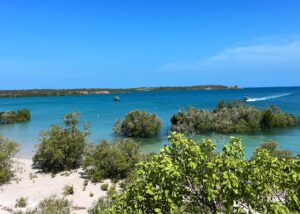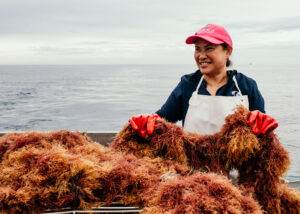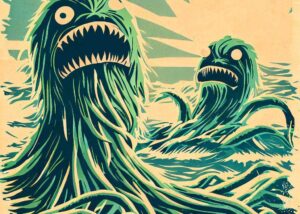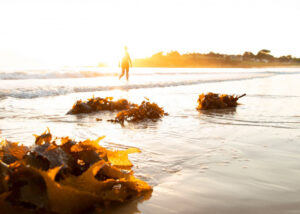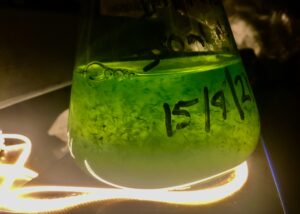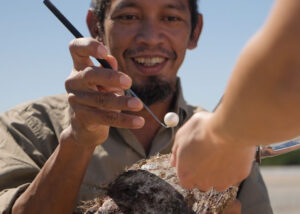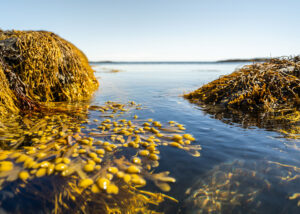In 2015, Jo Lane bought a seaweed ‘cottage industry’ on a whim. Now she’s charting a course to establish Australia’s first commercial kelp farm – but it’s not all plain sailing.
If only life were this simple…
In January 1970, Women’s Weekly magazine ran a story on ‘The Kelp Lady’, Betty Long. With her two kids, Betty combed the empty beaches of Narooma NSW, collecting ‘golden kelp’ which she washed by hand, air-dried on racks and sold as a restorative product under her brand, Sea Health. The story paints Betty as something of a castaway, swapping her urban life in Sydney for an idyllic existence in a less-trodden part of the world, sweetly advocating for the restorative powers of kelp.
Though the feature doesn’t say so, Betty Long’s business was very likely Australia’s first commercial seaweed operation – and very much the shape of things to come.
Fifty-three years later, seaweed is regularly in the mainstream press as a nascent wonder-stuff. Natural, nutrient-rich and sustainable, it’s poised to make huge impacts on sectors as disparate as materials technologies, CO2 mitigation and food supply. Kelp is a large brown seaweed that grows extremely quickly in underwater forests – and demand for it at scale is similarly growing across the world.
Enter Jo Lane, a resident of Tilba Tilba in NSW and a woman on a mission to set up Australia’s first commercial kelp farm…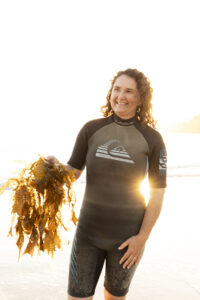
Jo was born a year after the Women’s Weekly feature on Betty Long appeared. Jo grew up with an interest in naturopathy, but was gently steered by her parents into her other two interests, marine science and the environment.
“I studied science subjects at Macquarie University and got a job at Oceanworld aquarium in Manly,” she says. “It opened my eyes to how amazing the marine world is. Then I did a postgrad Diploma in Environmental Studies – this was back in the ’90s when we had coral bleaching and I was first being made aware of climate change.”
In 2002, Jo moved to NSW’s Far South Coast, to the village of Tilba Tilba which happened to be located about 10 kilometres from Betty Long’s beachside property and her Sea Health business. “I was working for the Department of Primary Industry and part of my job was processing permits and fishing quotas. I ended up doing the permit for Sea Health to collect kelp – that was in 2005 and by then it was owned by Betty’s son, Scott.
“Ten years later I ended up buying the business.”
Specifically, Jo bought Betty’s brand as well as her original milling machine which minced raw kelp for Sea Health’s iodine supplements and food seasoning.
“I was probably having a midlife crisis!” laughs Jo. “It was very scary – I’ve never had a clue about business. But you don’t study science and conservation to make money. You do it to follow something that you’re interested in learning about – and also, hopefully, to make some positive change.”
Jo took up where Betty and family had left off, running a little artisan business that began each morning with her getting up before dawn to load her basket with beached ‘golden kelp’ – actually Ecklonia radiata, more commonly known as brown kelp, spiny kelp or leather kelp. Jo updated the Sea Health website, repackaged the products and of course began immersing herself in all things kelp…
“It became all-consuming. The more I Googled ‘kelp’ the more I discovered. It was like, ‘Wow! You can put seaweed in shampoo, in cosmetics, in pet food, in human food, in animal fodder, in fertilizer…’”
Jo began to expand her range to include skin care products, soaps and soaks. But she was soon pulled up by a simple reality: “We needed more kelp! We couldn’t collect enough to do all the things I wanted. I knew people were farming it overseas, so I thought the same would be happening here. And that’s when I was flabbergasted to find there were no kelp farms in Australia.”
During her research, Jo found herself ‘fixated’ with a US company called GreenWave, led by ex cod-fisherman Bren Smith and scientist Charles Yarish. The company operates around the cold waters off Maine, aiming to provide the training and tools to support 10,000 regenerative ocean farmers who will in turn plant one million acres with kelp species. They also say they’re charting a course for ‘ecological redemption’.
“Kelp is the planet’s fastest growing organism and absorbs huge amounts of CO2,” says Jo. “This in turn reduces ocean acidification, which then helps other organisms to grow – like mussels and oysters. It means that kelp is the ideal plant for co-farming or 3D-farming.”
In 2018, Jo applied for a Churchill Fellowship with a proposal to ‘investigate appropriate technologies for introducing kelp farming aquaculture to Australia’. She spent 12 weeks travelling to countries including Korea, Ireland, Norway and the US, before returning to NSW with her ‘mind blown’.
“I learned it really doesn’t have to be high tech. And some of it is copying successful models from other ocean farming industries like mussel farms and oyster farms.”
Armed with her Fellowship report, a 12-week accelerator program from the Bega Valley Innovation Hub and a seriously good story of economic and environmental benefits, Jo thought her vision for Australia’s first kelp farm would soon be a reality.
Her first hurdle came from the kelp itself which is endemic to Australia’s cold southern waters.
“The biggest challenge was to understand the lifecycle and how to actually grow it. I tracked down a couple of scientists who’d studied Ecklonia radiata but they’d done different parts of the lifecycle, not the whole – and certainly not in a commercial way to grow it with a view to planting.”
To fill these knowledge gaps, Jo began running experiments in her shed in Tilba Tilba. Her aim was to create an efficient Ecklonia hatchery, which would in turn provide seedstock for a farm. “Kelp grows really well in cold water, so I was trying to keep the water at around 15 to 16 degrees. But in summer, when the air temperature was 30 degrees, it was really difficult.
“Luckily, my husband’s background is air conditioning and refrigeration – so he said let’s build a proper lab.”

After construction, Jo had a significant breakthrough. “We have a broodstock collection permit through Fisheries to collect the reproductive tissue of kelp, which is called ‘sorus’. But the wild tissue is seasonal, so you have to get it at the right time. If you use up all your sorus, you have to wait for the next season. “We take the tissue into the lab, and get it to release zoospores, which turn into gametophytes; they fertilise and turn into little sporophytes, which grow into bigger kelp plants. The breakthrough came when we found that if we kept the gametophytes under red light, they didn’t fertilise – which meant we could keep the seed stock alive, bubbling away under red light. So instead of having to go back out and try to locate seasonal sorus, we were able to seed at any time of the year – which meant we could keep experimenting.”
In 2022 Jo secured international funding from the Safe Seaweed Coalition to once again upgrade the lab facilities. “We weren’t a cottage industry anymore,” she says. “Mentally, it lifted us. We just kept working until we’d cracked the whole lifecycle.”
The hatchery was sorted, but there was another challenge looming. And it couldn’t be solved in a lab.
After several years spent issuing licences for Fisheries, Jo thought it would be a relatively simple matter of getting permission to run a few anchors and rope lines off the coast of Bermagui and Pambula to grow a native species. But she immediately ran up against the state government’s aquaculture strategy, which regards the project as an ‘SSD’, or State Significant Development.
“All SSDs require a thorough and complex Environmental Impact Assessment – and they cost about $400,000. That’s a significant amount for a small business to find.”
Today, Jo’s in a Catch-22 situation: she doesn’t want to spend the money on the EIA unless she can prove up the farming concept; but she can’t set up an experimental site without an EIA…
“A kelp farm hasn’t been tried here before, so we don’t know if it’s going to work. We don’t know if we’ve got a good site, or how the kelp will grow best, or which rope lines will work, or whether to run the lines north-south or east-west…”
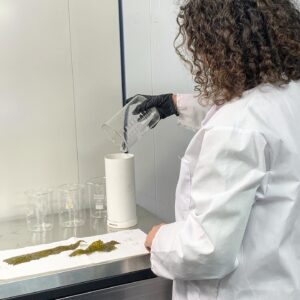 Meanwhile, the supply of natural kelp appears to be dwindling. “Since La Nina, the water temperature has increased, the sea urchin populations have gone crazy and the kelp forests here are declining. So the kelp that’s washing onto the beach is considerably less than when I first bought the business.”
Meanwhile, the supply of natural kelp appears to be dwindling. “Since La Nina, the water temperature has increased, the sea urchin populations have gone crazy and the kelp forests here are declining. So the kelp that’s washing onto the beach is considerably less than when I first bought the business.”
The situation is also being exacerbated by increasingly hungry Australian start-ups. “I think we’re the only non-university hatchery in Australia and I’m getting people calling me up all the time – they want kelp to put in their plant-based burgers, kelp to put in their shampoo, kelp to make bioplastics… But we can’t do all these great things with kelp unless we’ve got the real product.”
In 2022, Jo reached out to Marine Bioproducts CRC.
“We’re in Program One, which is creating sustainable biomass. At this stage, we’re hoping MBCRC will put us together with a PhD researcher to help answer some of the questions we have about growing kelp. These are fundamental questions, like how much carbon dioxide does kelp actually absorb? How many nutrients does it absorb? Has it got more iodine when it’s younger or older?
“But I’m also hoping that MBCRC can be a united voice for the emerging industry and help us educate government on the importance of growing this industry.”
According to Jo, Australia imported $40 million worth of seaweed-based products in 2018. “And it’s sure to be higher now. These are all products that we could be manufacturing here in Australia if only we had that base biomass. But we can’t have that scaled-up biomass – at least not yet in NSW – because we don’t have the regulatory system to allow me to easily farm a native species at scale.”
Jo is currently applying for a $2.6 million grant to create a seaweed innovation hub, with a view to expanding the hatchery and progress ocean trials. And she says there is a work-around on the horizon, albeit a long way from the beaches of Tilba Tilba. “I’m exploring options in other states where regulations are less prohibitive,” she says.
“But all I’m wanting to do is plant a native species in the ocean. I can plant any native tree species I like on land, but there’s still no farmed kelp in the waters of Australia. And I find that astonishing.”
For now, the nascent seaweed industries of Australia are still reliant on foreign growers or what can be hand-harvested on our shores by a few licensed artisans. Jo Lane is the first to admit how sublime it is to head out before the sun rises and collect golden kelp for mincing in Betty Long’s original 1970s mill. But she will be just as gratified to see the dawn of a new marine-based bio-industry – and the many benefits that will surely come.
More information: www.seahealthproducts.com.au



